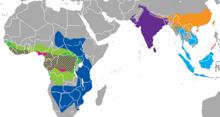Manis
Appearance
| Asiatic pangolin | |
|---|---|

| |
| Living pangolins from genus Manis | |
| Scientific classification | |
| Domain: | Eukaryota |
| Kingdom: | Animalia |
| Phylum: | Chordata |
| Class: | Mammalia |
| Order: | Pholidota |
| Family: | Manidae |
| Subfamily: | Maninae Gray, 1821 |
| Genus: | Manis Linnaeus, 1758 |
| Type species | |
| Manis pentadactyla Linnaeus, 1758
| |
| Species | |

| |
| Synonyms[2][3] | |
|
synonyms of subfamily:
synonyms of genus:
| |
Manis ("spirit") is a genus of South Asian and East Asian pangolins, the Asiatic pangolins, from subfamily Maninae, within family Manidae.[5][6]
Etymology
[edit]Carl Linnaeus (1758) invented the Neo-Latin generic name Manis apparently as a feminine singular form of the Latin masculine plural Manes, the Ancient Roman name for a type of spirit, after the animal's strange appearance.[7]
Taxonomy
[edit]- Subfamily: Maninae (Asiatic pangolins)
- Genus: Manis (Asiatic pangolins)
- Manis crassicaudata (Indian pangolin)
- Manis pentadactyla (Chinese pangolin)
- †Manis hungarica
- †Manis lydekkeri
- Subgenus: Paramanis
- Manis culionensis (Philippine pangolin)
- Manis javanica (Sunda pangolin)
- Manis mysteria[8][9]
- †Manis palaeojavanica (Giant asian pangolin)
- Genus: Manis (Asiatic pangolins)
Phylogeny
[edit]Phylogenetic position of genus Manis within family Manidae.[10][11][1]
| Pholidotamorpha |
| |||||||||||||||||||||
(Pholidota sensu lato)
|
References
[edit]- ^ a b Philippe Gaubert, Agostinho Antunes, Hao Meng, Lin Miao, Stéphane Peigné, Fabienne Justy, Flobert Njiokou, Sylvain Dufour, Emmanuel Danquah, Jayanthi Alahakoon, Erik Verheyen, William T Stanley, Stephen J O’Brien, Warren E Johnson, Shu-Jin Luo (2018) "The Complete Phylogeny of Pangolins: Scaling Up Resources for the Molecular Tracing of the Most Trafficked Mammals on Earth" Journal of Heredity, Volume 109, Issue 4, Pages 347–359
- ^ Palmer, Theodore Sherman (1904). Index Generum Mammalium: A List of the Genera and Families of Mammals. U. S. Government Printing Office. p. 822.
- ^ "Taxonomic history of the genus Manis". Mikko's Phylogeny Archive. Retrieved 2019-09-18.
- ^ J. E. Gray. (1825.) "An outline of an attempt at the disposition of Mammalia into Tribes and Families, with a list of genera apparently appertaining to each Tribe." Annals of Philosophy, new series 10:337-344
- ^ "Oldstyle id: d36852dde74a91d7c965591b175947ec". Catalogue of Life. Species 2000: Leiden, the Netherlands.
- ^ Schlitter, D.A. (2005). "Order Pholidota". In Wilson, D.E.; Reeder, D.M (eds.). Mammal Species of the World: A Taxonomic and Geographic Reference (3rd ed.). Johns Hopkins University Press. pp. 530–531. ISBN 978-0-8018-8221-0. OCLC 62265494.
- ^ "ITIS Report Manis Linnaeus, 1758". Retrieved May 28, 2018.
- ^ Huarong Zhang, Mark P. Miller, Feng Yang, Hon Ki Chan, Philippe Gaubert, Gary Ades, Gunter A. Fischer (2015.) "Molecular tracing of confiscated pangolin scales for conservation and illegal trade monitoring in Southeast Asia", Global Ecology and Conservation, Volume 4, Pages 414-422
- ^ Jingyang Hu, Christian Roos, Xue Lv, Weimin Kuang, Li Yu (2020.) "Molecular Genetics Supports a Potential Fifth Asian Pangolin Species (Mammalia, Pholidota, Manis)" Zoological Science, 37(6):538-543
- ^ Gaudin, Timothy (2009). "The Phylogeny of Living and Extinct Pangolins (Mammalia, Pholidota) and Associated Taxa: A Morphology Based Analysis" (PDF). Journal of Mammalian Evolution. 16 (4). Heidelberg, Germany: Springer Science+Business Media: 235–305. doi:10.1007/s10914-009-9119-9. S2CID 1773698. Archived from the original (PDF) on 2015-09-25. Retrieved 2020-11-19.
- ^ Kondrashov, Peter; Agadjanian, Alexandre K. (2012). "A nearly complete skeleton of Ernanodon (Mammalia, Palaeanodonta) from Mongolia: morphofunctional analysis". Journal of Vertebrate Paleontology. 32 (5): 983–1001. Bibcode:2012JVPal..32..983K. doi:10.1080/02724634.2012.694319. ISSN 0272-4634. S2CID 86059673.
